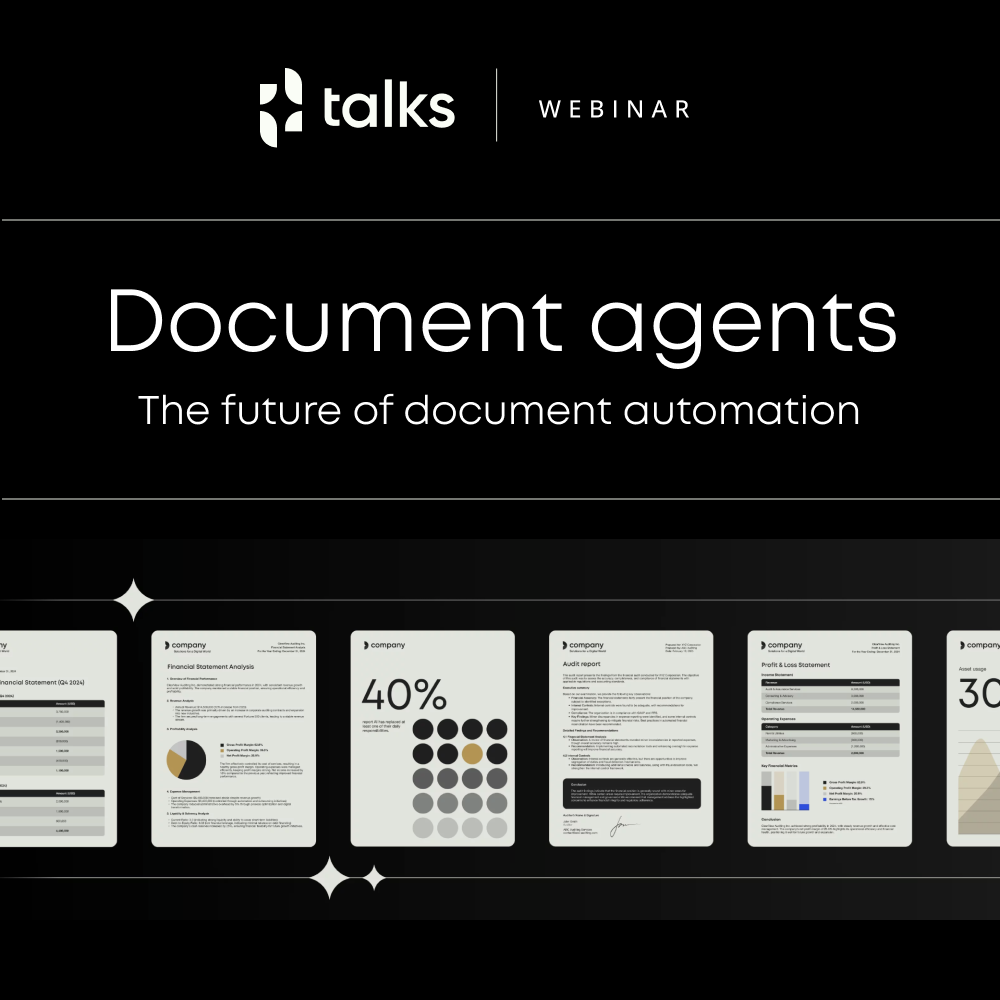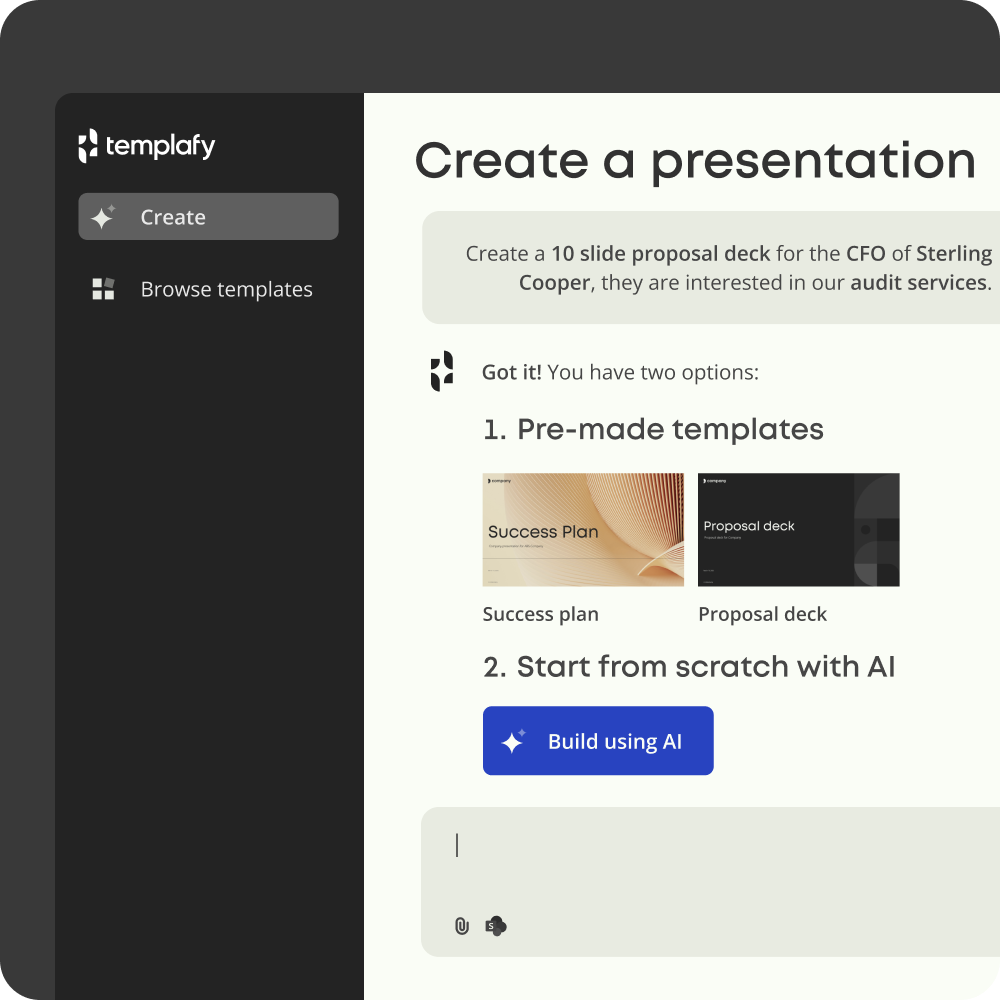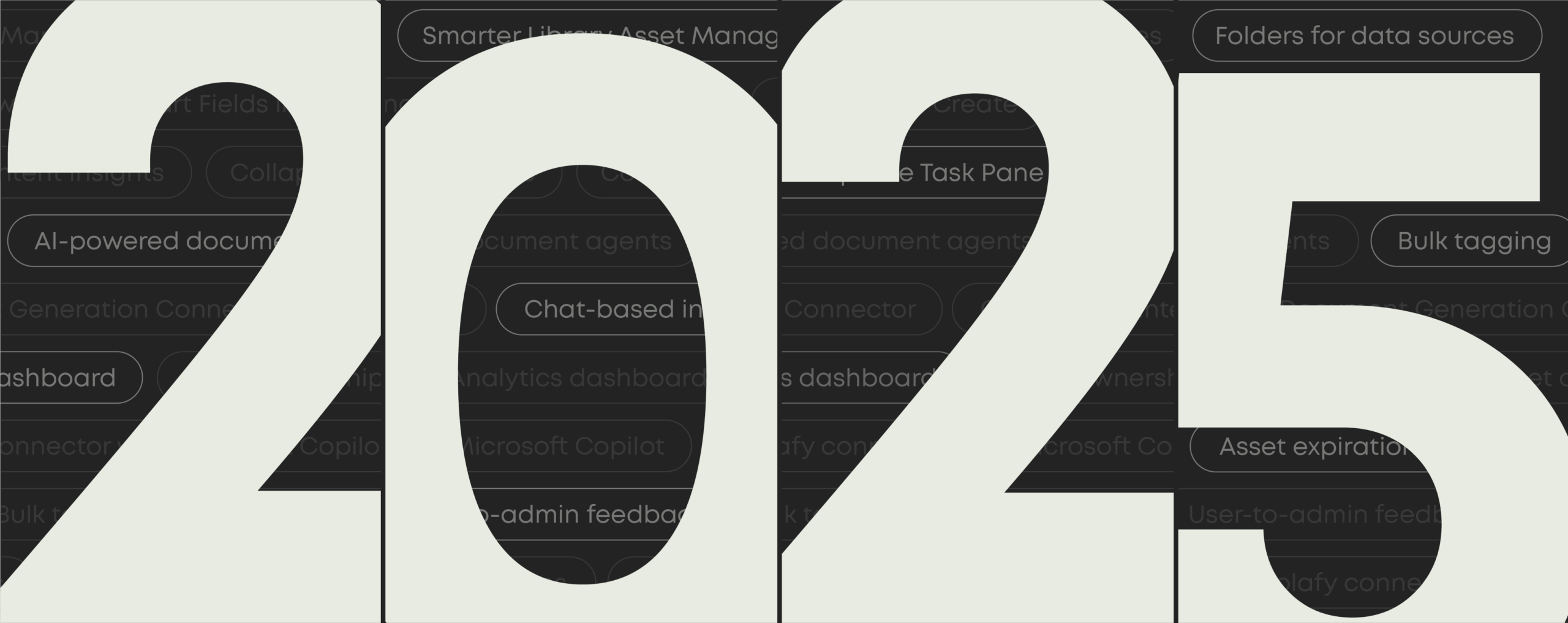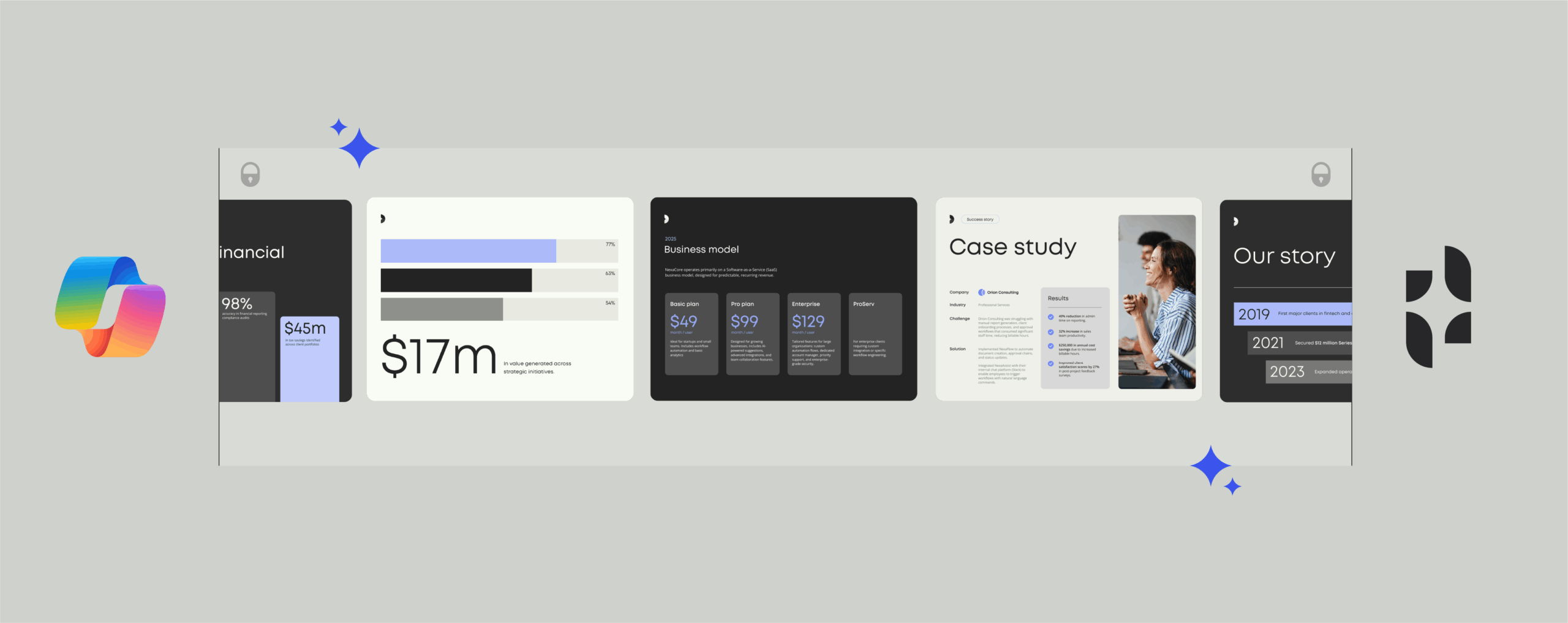How to build an enterprise AI strategy that scales, sticks, and delivers ROI
AI-first? Let’s get the strategy right first.
If you’re not embedding AI into everything you do, your competitors are getting ahead.
As Allie K. Miller—the most-followed voice in AI and a trusted advisor to Fortune 500 companies—said in her keynote at Templafy Connect:
“The companies thriving in the AI era are becoming AI-first businesses. That means embedding AI into workflows, products, and customer experiences—not treating it as an afterthought.”
In fact, GenAI investments are projected to increase by 60% in the next three years. (BCG)
What’s more, companies that have fully embedded AI into their operations are seeing 2.5 times higher revenue growth and 3.3 times greater success at scaling impactful Gen AI use cases. (Accenture)
There’s no shortage of flashy new AI solutions on the market, from copilots to vertical-specific LLMs. But success won’t come from throwing investments at every shiny new tool. 75% of executives rank AI/GenAI as a top three strategic priority—but only 25% are seeing significant value from AI. (BCG)
The companies achieving real ROI are embedding AI where it matters, with the right governance, structure, and scale.
This blog breaks down exactly how to do that—and why document automation is the best place to begin if you want enterprise-wide impact that you can actually measure.
ADDITIONAL CONTENT
Embed AI where it matters most—your documents
Discover how Templafy’s document agents work inside Word, PowerPoint, Excel, and Copilot to keep every document accurate, compliant, and on-brand.


Why building an AI strategy matters
Rolling out AI without a solid strategy creates more problems than it solves. A reactive approach puts your people, brand, and bottom line at risk.
Here’s what happens when you skip the groundwork:
- Inaccurate or low-quality outputs that damage trust and require manual rework
- Off-brand or inconsistent content that weakens your company’s identity
- Compliance breaches that expose you to legal or regulatory consequences
- Data privacy violations from unvetted tools or unchecked usage
- Wasted investment in disconnected pilots that never scale
- Environmental impact from inefficient model usage
- Workforce disruption with no reskilling or training plan
- Ethical concerns around bias, transparency, and accountability
7 pillars of a strong AI strategy
Before you choose tools, write prompts, or build models, start here. A solid strategy should be aligned with your goals, connected across teams, responsible in its use, and ready to scale.
1. Start with business goals
AI isn’t the goal—your business outcomes are. Start by asking: What are we trying to achieve? Faster, higher-quality document creation? Reduced manual rework? Stronger brand and legal compliance across teams and regions? Then build your AI plans around those goals, not the other way around.
2. Fix your data
AI needs clean, structured, accessible data to deliver anything useful. If your systems are full of gaps or inconsistencies, the outputs will be low-quality and unreliable.
Before you start, take stock of the data your AI will depend on. That means auditing CRM fields, product info, SharePoint content, and internal knowledge bases. Standardize what you can, clean up what you need to, and make sure it’s accessible to the right people and tools.
3. Avoid fragmentation from the start
Scattered pilots might feel productive, but they often create duplicated efforts, inconsistent results, and tools that don’t talk to each other.
Instead, define shared content and compliance standards, set up cross-team collaboration, and choose solutions that plug into your existing workflows. That way, you avoid fragmentation and build something sustainable.
4. Invest in your people
The best AI in the world won’t deliver if people don’t know how to use it. Writing great prompts, interpreting outputs, and applying critical thinking—that’s human work.
Help every team understand where AI fits into their day-to-day and how to use it with confidence.
5. Lead with governance
Governance is your AI safety net. It’s how you define ownership, set rules, and build transparency into every use case. It’s what keeps AI ethical, secure, and aligned with your business values.
That includes:
- Assigning ownership and accountability for AI use cases
- Controlling access to prompts, models, and training data
- Tracking how AI is used, by whom, and where
- Keeping records of data sources and logic behind generated content
- Protecting sensitive information through enterprise-grade security frameworks (e.g. SOC 2, ISO 27001)
- Considering sustainability and compute impact (e.g. energy use, model choice, ISO 14001 alignment)
6. Embed AI into everyday workflows
When AI is embedded into familiar workflows, it’s smoother to adopt, easier to govern, and more likely to deliver real value.
Choose tools that:
- Integrate directly with everyday apps like Microsoft Office and SharePoint
- Require minimal training and are intuitive to use
- Support everyday tasks like formatting, data retrieval, and document assembly
- Deliver value immediately—without disrupting the way people work
7. Choose tools that scale and adapt
AI is constantly evolving, and your tech should be too. As new use cases emerge and regulatory requirements shift, you need tools that can flex without forcing you to start over.
Look for:
- Modular architecture that supports expansion
- Enterprise-grade security and permission controls
- Configurable features that work across global and local teams
ai
How to build an AI strategy
Here’s a step-by-step guide to help you plan, implement, and scale AI across your organization.
- Define measurable business objectives
- Conduct a comprehensive capability assessment
- Develop a pragmatic AI roadmap
- Select tools and partners aligned with your vision
- Build organizational AI capabilities
Keep up with AI
Get practical tips and real stories on how AI is changing document work. Stay informed and make smarter choices for your team.
1. Define measurable business objectives
Begin by setting clear, quantifiable goals that align with your organization’s priorities. These objectives should be specific and outcome-driven.
Examples:
- Increase document workflow productivity by 20%
- Reduce proposal turnaround time by 50%
- Eliminate 90% of manual content rework
- Achieve 100% compliance in audit report submissions
Case study: Tietoevry implemented Templafy to streamline document creation, resulting in over 100,000 brand-compliant documents and significant efficiency gains across the company.
2. Live charts and real-time data
Before you move forward, get a clear picture of where you stand. A capability assessment helps identify what’s working, what’s missing, and what needs to change to support enterprise AI. This includes evaluating your systems, data foundations, and internal skill sets.
Key areas to evaluate:
- Technology: Can your existing platforms support AI-driven workflows at scale? Are there integration gaps or legacy systems that could slow progress?
- Data: Is your data clean, structured, and accessible across teams? AI is only as good as the data it runs on.
- People: Do you have the right expertise in place—or a plan to build it? Consider technical, operational, and governance capabilities.
3. Develop a pragmatic AI roadmap
Avoid overambitious plans that attempt to overhaul everything simultaneously. Instead, focus on achievable milestones that build toward long-term impact.
Your roadmap should include:
- Prioritized use cases based on value and feasibility
- Realistic timelines
- Defined KPIs linked to business outcomes
- Resource allocation plans
- Feedback mechanisms for continuous improvement
According to McKinsey’s report, organizations with a clear methodology for developing analytics models, interpreting insights, and deploying new capabilities are 2.5 times more likely to succeed compared to their peers.
4. Select tools and partners aligned with your vision
Choose technology solutions that integrate seamlessly with your existing infrastructure and support your strategic objectives.
Considerations:
- Compatibility with current tools (e.g. Microsoft 365, SharePoint)
- Built-in compliance and governance features
- Support for both rule-based and generative AI capabilities
5. Build organizational AI capabilities
Developing AI proficiency across the organization is essential for sustained success.
Actionable steps:
- Establish cross-functional teams to oversee AI initiatives
- Invest in training programs to upskill employees
- Create internal communities of practice to share knowledge and best practices
Why document automation is the answer
Documents are where strategy meets execution. Sales proposals, audit reports, contracts, agreements—they’re how work moves forward.
But without automation, they’re also where everything slows down.
- According to Microsoft, 1.2 billion knowledge workers create 500 billion business documents globally each year—an average of 417 documents per worker annually. (Microsoft)
- 50% of knowledge workers’ time is spent creating or prepping documents (The ECM Consultant)
- The average enterprise loses $12.9M annually to poor content and data quality (Gartner)
- Compliance breaches from manual doc errors are 2.7x more likely (Ponemon Institute)
That’s why document automation is the single best place to start your AI strategy. It’s company wide, high-impact, and measurable. And it delivers results you can see right away—without disrupting your teams.
Unify, govern, and scale Gen AI with Templafy
Templafy is the document generation platform built to unify and scale AI across the enterprise—while keeping every file compliant, on-brand, and easy to create.
Here’s how:
Eliminate fragmentation with centralized control
Too many companies waste time managing scattered templates, content, and tools. Templafy brings it all into one place—so everyone’s working from the same source of truth.
Fast documents, without cutting corners
Templafy blends rule-based automation with GenAI to help teams create documents in a fraction of the time, without losing quality, accuracy, or brand consistency.
Compliance and control, built for enterprises
Security, brand integrity, and compliance aren’t bolted on—they’re built in. With enterprise-grade frameworks like SOC 2, SOC 3 and ISO 27001, Templafy keeps sensitive content protected and every document audit-ready.
Let document agents do it for you—our latest AI innovation
Templafy’s new document agents take document generation even further. They’re powered by conversational AI, so a simple chat interface guides you through the creation process. That means there’s no need for additional training or prompting expertise.
Just ask for what you need and document agents do the heavy lifting. They pull the right content into place and apply brand and compliance rules automatically—all from inside the tools your teams already use, like Word, PowerPoint, and SharePoint.
Think of them as smart assistants for your documents. They help teams create client-ready content that’s fast, accurate, and always on-brand.
Seamless integration with Copilot
If your organization uses Copilot, Templafy offers effortless integration. You can choose to:
Option 1:
Build your documents with Copilot—Templafy ensures brand and compliance by applying the correct template, tone of voice, and brand assets through the Microsoft Graph connector.
Option 2:
Build your documents with Templafy. Copilot provides the starting point from Teams, Word, or PowerPoint, and Templafy’s document agents take over to generate the document using admin-controlled templates.
Proven at enterprise scale
There’s a reason we’re trusted by KPMG, BDO, and iComm, and four million users worldwide.
- 92% faster proposal cycles
- 30% fewer document errors
- 3–4 hours saved per employee, every week
“Templafy has completely changed how we create documents. Everything’s faster, easier, and always on-brand.” – BDO Canada
Ready to see enterprise-ready document generation in action?
The best way to find out more about Templafy is to see it in action.
Book a demo to find out how Templafy’s AI-powered document generation platform and document agents keep every document on-brand, compliant, and faster-than-ever.




